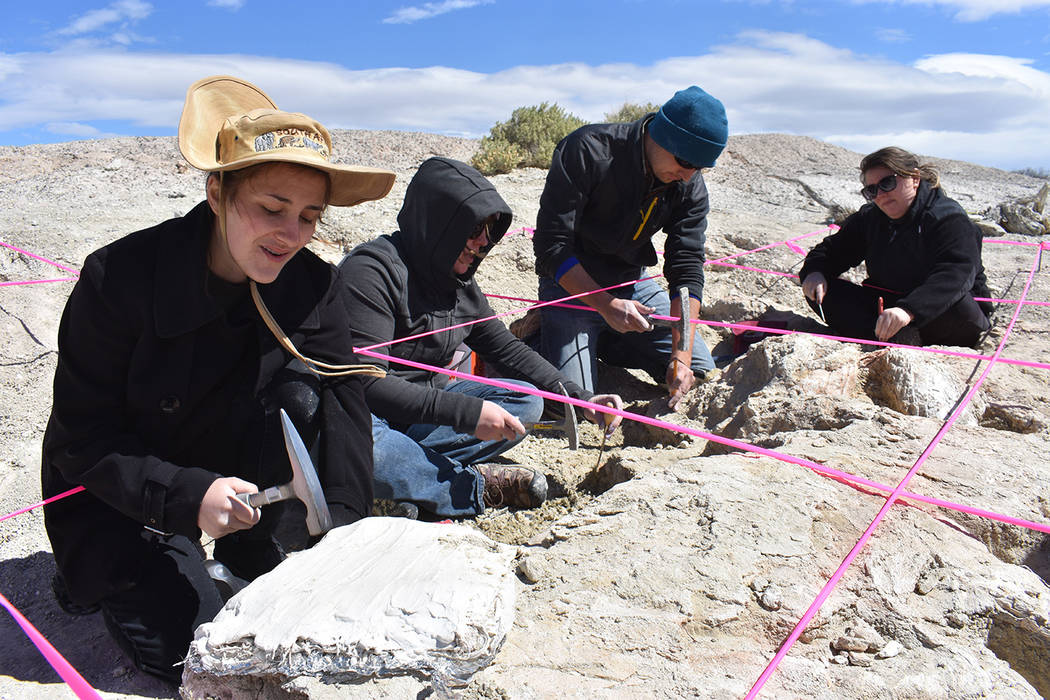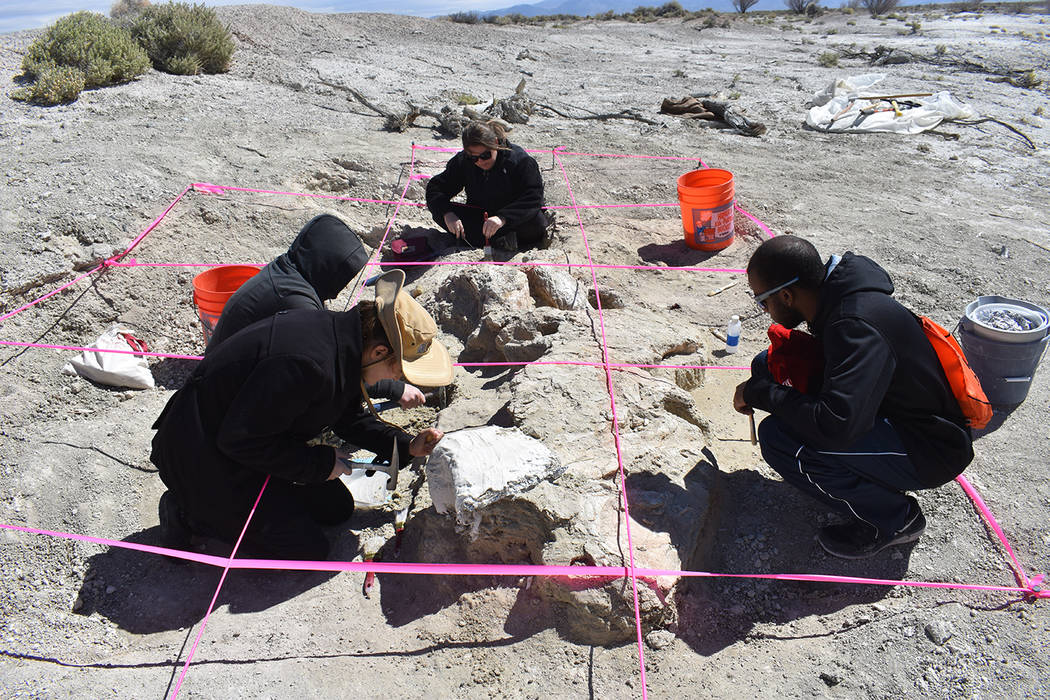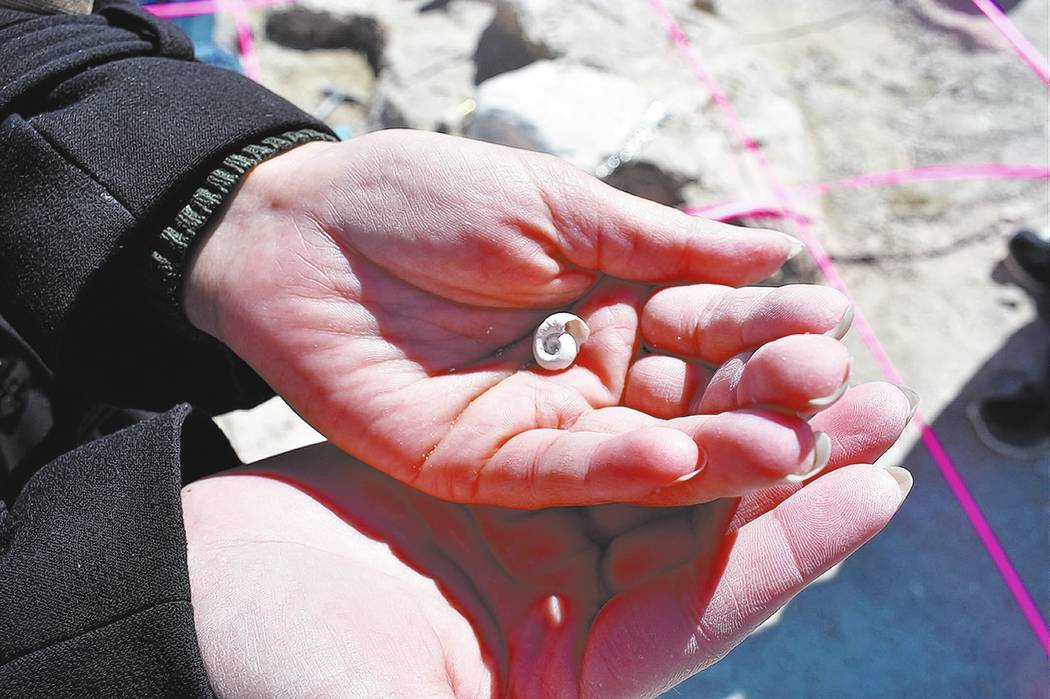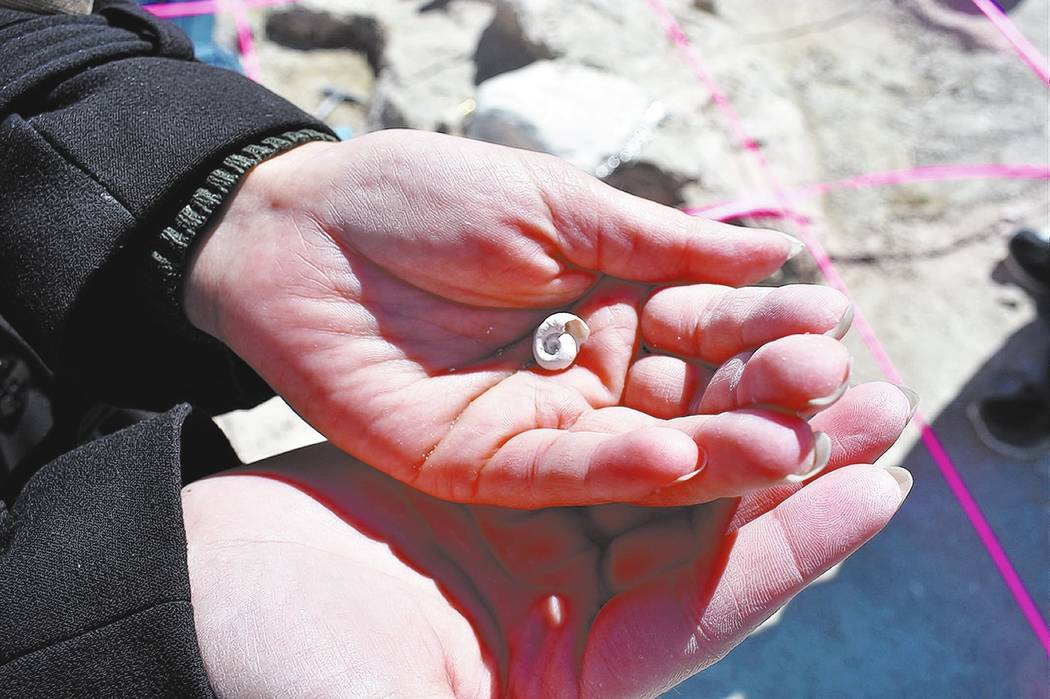Researchers unearth mammoth remains in remote Nye County
An accidental discovery of what researchers believe to be the skeletal remains of a Columbian mammoth in a remote part of Nye County grew into a paleontological excavation.
In the last five months, a group of University of Nevada, Las Vegas, students spearheaded by Steve Rowland, a UNLV geology professor, has unearthed a pair of giant tusks out of a barren patch of federally owned land.
“We don’t have enough of it yet to say for sure that it’s a Columbian mammoth, but that’s a 95-percent (chance ),” Rowland said.
As Rowland’s theory goes, the animal died about 20,000 years ago in the Pleistocene epoch, the time when the climate was colder and wetter than it has been in the last 100,000 years.
“When the mammoth was alive, this was a much wetter (area) than it is now,” said Rowland, motioning toward the dry area. “It was during the time called the last glacial maximum, when this area and North America, in general, was wetter and cooler.”
Researchers come to the site every two weeks and a typical day in the field lasts about six to seven hours. Friday’s weather brought gusty winds to the area, but that didn’t stop researchers from coming to the site.
A group of UNLV students, armed with brushes and dust pans, huddled around the skeletal remains. Some of them covered their faces from the blowing dust.
“With any excavation, it’s just trying to figure out where the bones go, because you can’t see underground, so we have to use our best estimate and knowledge of what the animal should have looked like to map an area around there,” said Fabian Hardy, who graduated from UNLV with his master’s in geology.
The animal’s skull is gone, and Rowland suspects it was cut off by a bulldozer that moved the dirt around in the area. Meanwhile, the tusks could be up to six feet long, he said.
“We are interested in trying to understand the environment that this animal lived in and part of the way you do that is to take some of the sediment,” he said. “Pollen is very resistant to decay, so some of the sediment that my students are digging through, I’m sure has pollen in it. So we will take some of this sediment sample and send it off to the pollen lab.”
Life history
Rowland first visited the site a little over two years ago after the U.S. Bureau of Land Management, who owns the land, got involved in the process.
The remains were discovered seven years ago by an area resident who noticed bones sticking out of the dirt while riding his motorcycle and reported it to the BLM.
The agency later invited Rowland to apply for a permit to excavate the mammoth at the undisclosed site.
Rowland believes the tusks are the key to the life history of the mammoth. He also hopes to find an answer to the question of why the Columbian mammoth became extinct. Some believe the species died off because of hunting, other theories say it happened because of the climate.
“You can actually tell how many years old this animal was when it died by studying the internal structure of the tusk. We can also tell what season it died because we can look at the very end of the tusk and tell whether it died in a season when it was growing quickly or slowly,” he said.
Rowland said he is sure it’s a male animal because of the tusks, and it’s about 40-50 years old. He also said it appears to have died when it was standing up and didn’t fall over after it died.
“We think that it died in a lake or a pond and its feet may have been stuck in the mud,” he said.
“We are trying to figure out how it died, what the circumstances were about how it died, so our working hypothesis is that it died in a fairly deep lake and the buoyancy of the water kept the body upright even after it died, and its head went straight down into the mud and the tusks got stuck in the mud, and eventually, the animal, the carcass would have been decayed,” Rowland said.
Rowland hopes to finish the excavation before the summer heat sets in and his students get busy during the break. Once the animal is out he said they plan to take it to the Las Vegas Natural History Museum, a recognized repository or federal land in Southern Nevada.
“A scientific excavation is a slow process, and it needs to be (this way) to make sure you are not ruining anything,” he said.
Rare find
Fossilized animals are typically discovered in the upper Midwest, and Rowland said to find one in Nevada is a rarity.
A site with tusks and a lot of other bones is also not typical.
“This is the first time I’ve been involved with a major mammoth excavation,” Rowland said.
The UNLV professor said he had excavated a mammoth’s tusks and tooth near Indian Springs. He has also been involved with mammoth tooth excavation in Tule Springs Fossil Beds National Monument.
But Rowland doesn’t rule out the possibility of other mammoths’ remains in Nye County.
He is now thinking about possibly coming out to the area with one of his colleagues and searching the area for other bones with ground-penetrating radar, a machine that goes into the ground and identifies different densities.
“In principle, you could survey lots of areas and see if there’s other buried bones, but the reality is, you can’t just go over hundreds of square miles and do that, you have to have a kind of focused site,” he said.
Such bones are sometimes unearthed during highway projects, or bulldozers that help to expose fossils.
“There’s lots of fossils around, but it’s impossible to know where they all are, unless they get discovered by accident,” he said.
Fundraising
April is Nevada’s Paleontology Month and Rowland says it’s “a good time” to interest people in fossils.
He also wants to use the dig as an opportunity to do crowd-funding for the project. Those who donate at least $500 will be able to go to the site and participate in the excavation process.
“When this project opened up, I thought, this is a good opportunity to get people excited,” he said.
Rowland said the price tag for the analyses, tests and some of the equipment used in the process could near a few thousand dollars.
“I would like to raise enough so that I can pay for that and then have some money in the account so the next time we want to go out in the field, we have a little bit of money,” Rowland said.
Contact reporter Daria Sokolova at dsokolova@pvtimes.com. On Twitter: @dariasokolova77

















